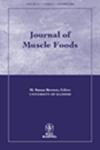MINERAL CONTENTS OF MUSCLE (LONGISSIMUS DORSI THORACIS) AND LIVER IN RIVER BUFFALO (BUBALUS BUBALIS)
Abstract
ABSTRACT
The aim of this study was to evaluate mineral contents of meat (longissimus dorsi thoracis muscle) and liver in 350 river buffalos (Bubalus bubalis) grazed on natural pastures in terms of gender and age. According to the results, there were significant differences (P < 0.0001) in the mineral concentrations between meat and liver except for sodium. Potassium occurred in the highest concentration in the meat followed by sodium, magnesium, calcium, zinc, iron and copper. In the liver, potassium was the most abundant mineral followed by sodium, iron, magnesium, calcium, zinc and copper. Gender did not have any significant effect (P > 0.05) on the mineral contents of the meat and liver except for iron (P < 0.001). Age affected all mineral concentrations in the meat and liver. Sodium, potassium, calcium and magnesium contents of meat increased (P < 0.001) with age. In the liver all of the measured minerals, except for magnesium, were increased significantly (P < 0.001) with age. However, the iron, zinc and copper contents of muscle and the magnesium content of liver were decreased with age (P < 0.001), respectively. Our findings showed that meat and liver of buffalo are suitable sources of iron, potassium and zinc.
PRACTICAL APPLICATIONS
Muscle is a dynamic tissue that performs mechanical, biological and chemical functions. Muscle development and its chemical and physical properties are affected by age, nutrition, hormonal status and disease. The mineral composition of meat from buffaloes grazed on natural pastures could be suitable as an alternative red meat for human consumption. The buffalo meat and liver are rich and good sources of potassium, zinc and iron. Buffalo meat has higher contents of iron than cattle meat and is recommended to be considered in iron scarce diets.

 求助内容:
求助内容: 应助结果提醒方式:
应助结果提醒方式:


